
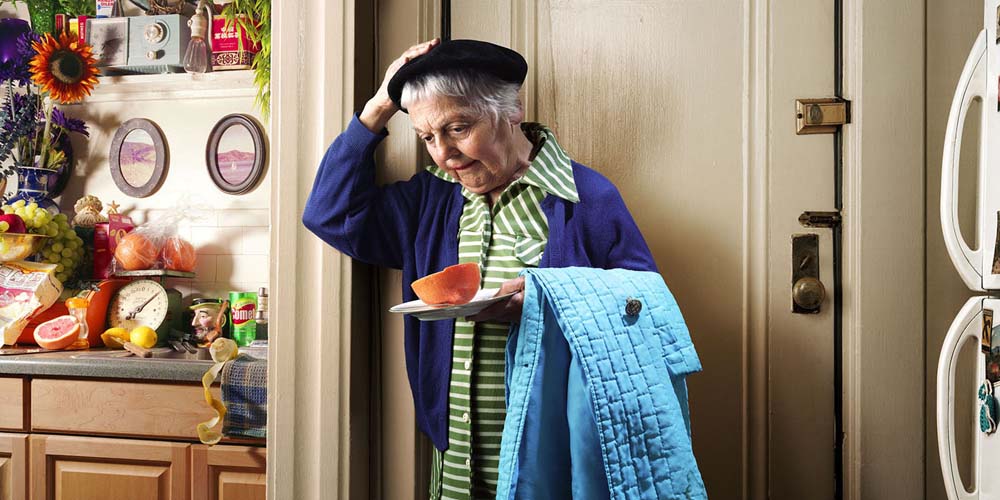

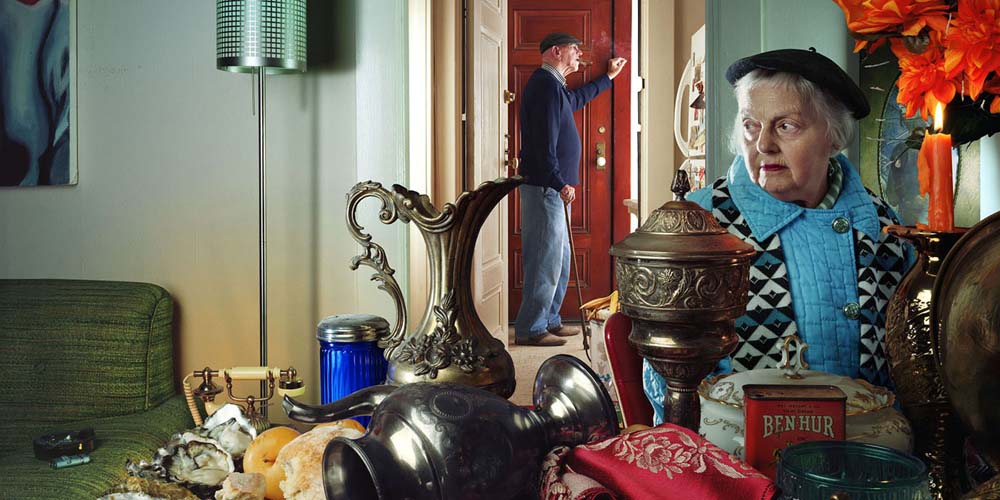
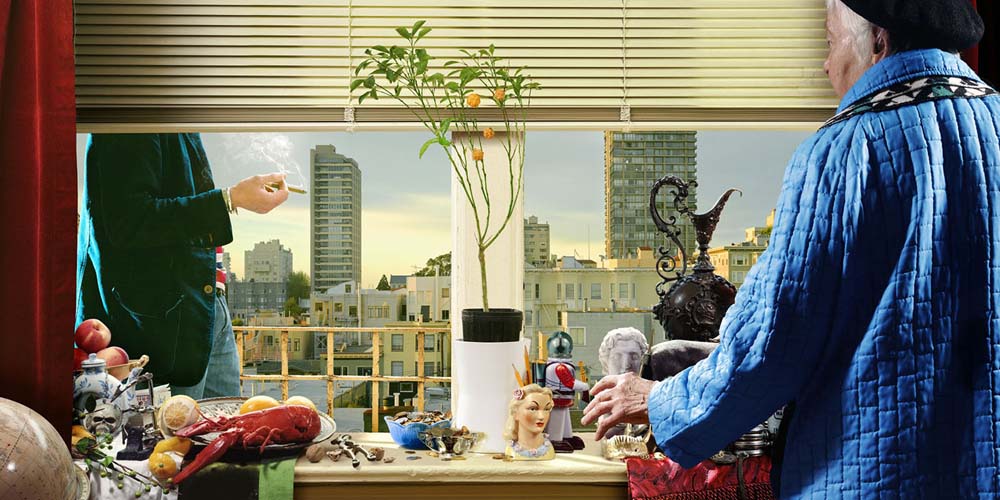
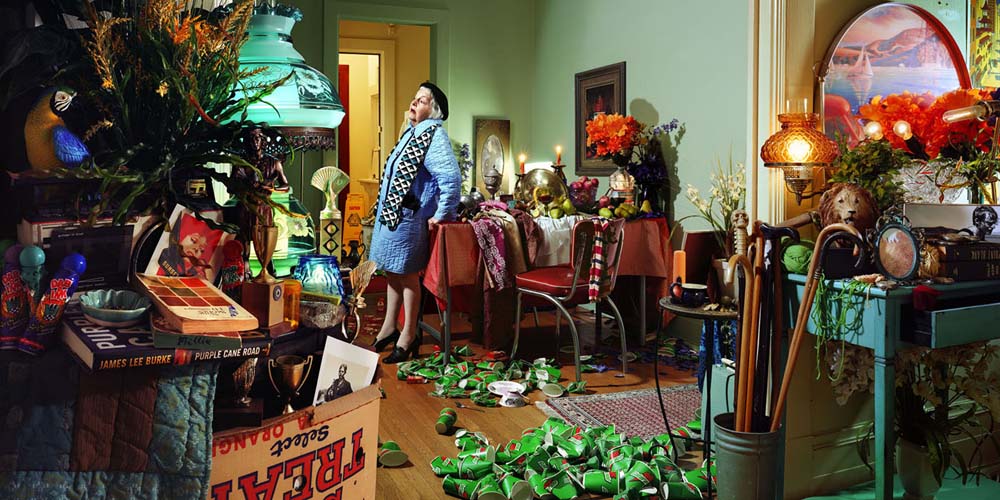
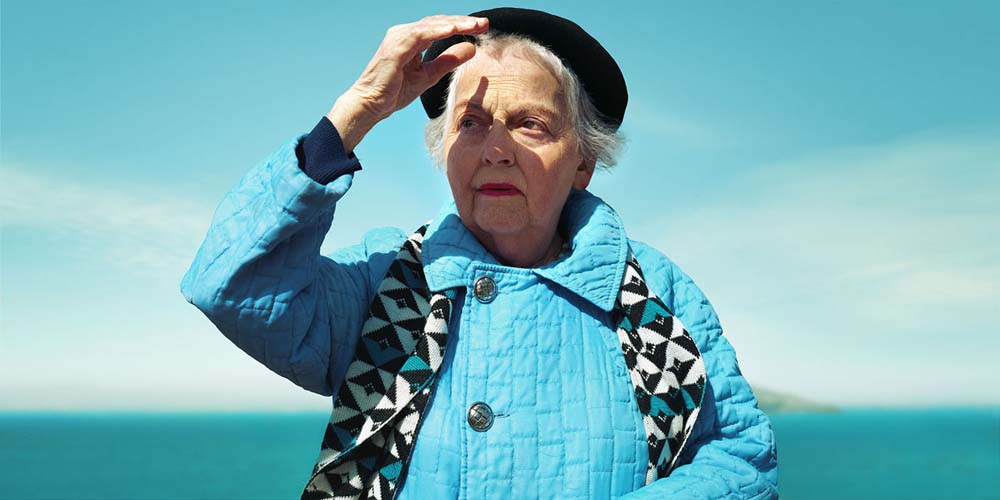

EXCELLENCE IN MULTIMEDIA: Artist's Statement
First Place: Rocky McCorkle
You and Me on a Sunny Day
Photographer Rocky McCorkle created the narrative and directed the photographs in the first ever “walk-through movie” with 88-year-old Gilda, “You and Me on a Sunny Day.” McCorkle’s series of 135 photographs is conceived as a silent film in the form of a sequence of stills. Gilda Todar’s (1927—2017) colorful life is revealed in photographs that share her memories. McCorkle has unrolled traditional cinema and extended it into the three-dimensional physical space. It is comprised of larger-than-life photographs that are displayed in chronological order on several connecting walls. For the movie to be watched, viewers shift from image to image, living movement brings the stills to life. Each viewer will see Gilda’s story unfold at their own pace, creating a visitor-flow and emotional experience like no other. Every Sunday evening for 5 years, McCorkle brought downstairs neighbor Gilda up for a photo shoot on a set that he had spent all week lighting, propping, and composing. It took an hour to make one image, and the next week they did it all over again—a process slower than clay animation. The interior shots were made in the artist’s Tenderloin apartment in San Francisco, which he transformed into a complex mise-en- scène for the storyboarded narrative. The protagonist in her own life story, the photographs tell the story of Gilda remembering, and at times dreaming about, her late husband Jack. Peering at her through the camera lens and surrounded by objects from her life, photographer and director McCorkle reveals the emotional complexity, both internal and external, that time, joy, love, struggle, death, loneliness and depth of feeling bring to a life well lived. Gilda was born in San Mateo in 1927 and waited her entire life to be an actress on the big screen. This was her first and last starring role.

EXCELLENCE IN MULTIMEDIA: Artist's Statement
Second Place: Annette Fournet
The Goddess Series
Digital Collage. Digital collage. 30W x 40” or 40W x 30H” In the Goddess Series I am using vintage photographic portraits of women. I transform each individual with digital collage into a particular mythological goddess. Disturbed and concerned by the regressive and repressive attitudes towards women found in current in political and religious groups today, I am moved to create images of women who can wield power (in positive or sometimes in negative behaviors). I am expressing the power, exotic, spiritual, and esoteric qualities of women. It is my small way of fighting back. This body of work evolved from my previous project, Anima/Persona. The Anima / Persona series began as an exploration of the persona (external projection of self) and the anima (inner soul). These digital collage portraits of women were influenced in part by Symbolist paintings. As a young art student I was fascinated by the symbolist and Decadent paintings. In these images I admired the reaction against the mundane, the banal, and bourgeoisie normalcy of the late 19th century. I later learned that many of these artists worked from misogynist fears stemming from their discovery that the Victorian notion that women did not have a sexual nature was untrue, and of their fear of the nascent women’s movement for equality. The elements of the Symbolist work that I found of interest were their reaction against the mundane, the banal, and bourgeoisie normalcy of the late 19th century.

EXCELLENCE IN MULTIMEDIA: Artist's Statement
Third Place: Kevin Mooney
366247•2012
366247•2012 is a time-based piece, rooted in still photography, and can be presented as a video or video projection installation. The more than 256,000 still images, presented as a photographic stop-motion animation, allow the viewer to witness my day-to-day routines, the same acts that everyone engages in on a regular or daily basis. Time. How do you perceive it? Is it fleeting or does it seem to go on forever? When did you first become aware of “time”? Do the minutes, hours, days blend together? Are the memories of events just as vivid now as when they actually occurred? Do memories play a significant role in what time means to you? Where does the “time” go? Is it measured in the outcomes of our daily routines or in the singular outliers, the spectacular moments that occur irregularly and unexpectedly? This piece reveals my regimented routines over the course of a single year. When interacting with the piece, these routines become patterns. When the patterns change, the viewer is left to consider the reason why. The images presented are my visual memories of events. In watching the piece, viewers have the opportunity to consider the past and the future simultaneously, to see the outcome before the event has actually occurred. The entire year (2012) is presented as a grid, with each image representing a day in each month of the year, starting at approximately midnight on the first day of each month and continuing to the final day of the month. From left to right, January through December is presented in its entirety until each fades into darkness. By de-constructing how a visual representation of a year is normally presented, the viewer visits an abstract representation of that year. Ultimately, a year of my life is presented in an hour, offering the viewer an opportunity to participate and find meaning in my mundane activities while simultaneously reexamining their own unrecognized minutes, hours and days.

EXCELLENCE IN MULTIMEDIA: Juror's Statement
Josh Raab
Director of Instagram, National Geographic; formerly Multimedia Editor, TIME Magazine
This year brought a multitude of impressive submissions ranging from still photography to Augmented Reality. There were strong projects across the board that pushed the boundaries of traditional media from collage that challenged the depictions of women in traditional photography, to video montages that challenged the perception of time itself.
In You and Me on a Sunny Day, Rocky McCorkle spent years photographing his neighbor in elaborate sets that were simultaneously glamorous and daunting. These explosions of color give a peek into a fabricated life while inferring truths about Rocky’s subject.
In The Goddess Series, Annette Elizabeth Fournet used collage to redefine old imagery informed by Victorian values to make the women in them into “goddesses”. This brilliant use of mixed media brings modern life to the photographs and with it the much needed celebration of the subjects.
In 366247•2012, Kevin Mooney shot video of his life every day for a year, presenting the results side by side simultaneously. This crude approach displays the future, present, and past all at once, turning the mundane into a time machine and showing exactly how much time we spend in our cars.

